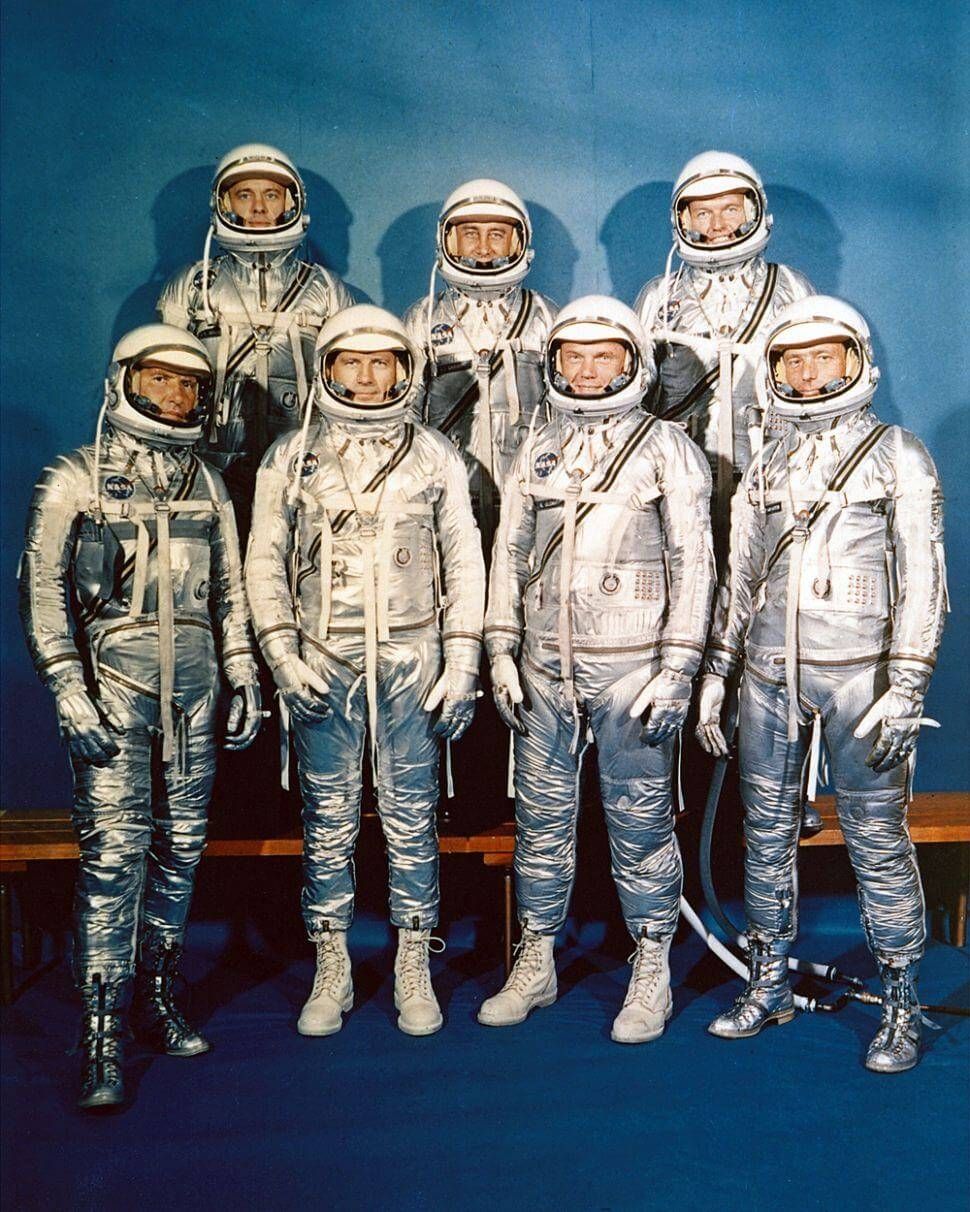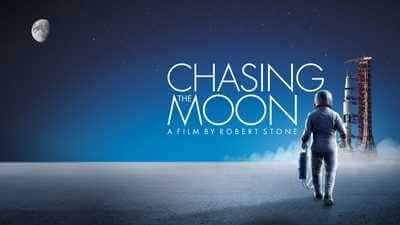The Men of Mercury 7 Chased Glory with 'The Right Stuff'
Tom Wolfe's book captures the guts and glory that propelled the Space Race.
Just when tensions between the Russians and the Americans reached a seismic peak in the 1950s, the Cold War found a new frontier: space. The great unknown beckoned in all its glittering blackness, but one question propelled the competition - which nation would be the first to send a human being beyond Earth's atmosphere?
In the 1940s, the U.S. leveraged Nazi V-2 rockets captured after World War II to test the impact of space on living creatures during a time when several myths persisted. The extreme pressure of space might crush a human skull; eyeballs might spring out of their sockets like jack-in-the-box toys. In 1947, American scientists sent fruit flies into space to test the impact of radiation exposure at high altitudes; then in 1948 the first Albert, a rhesus monkey, flew into space, only to die of suffocation. In other words, many experiments - and a slew of failures and breakthroughs - led to the Space Race of the late 1950s and 1960s. But many questions remained about the effects of space travel on the human body.
Enter the unlikely figure of Tom Wolfe. One of the figureheads of New Journalism. Supposedly the first journalist to use the present tense in a magazine profile story. The Man in White - who never would have been known by that moniker had he not purchased a white summer suit cut from a cloth too heavy for the humidity of 1962. So he wore it in the winter, caused a stir as a result, and the suit became his trademark.
In 1972, Rolling Stone co-founder and editor Jann Wenner hired Wolfe to write about NASA's last moon mission, Apollo 17. The initial result was a four-part series on the depression that astronauts experience after flight in space, the penultimate mission of a lifetime that left many of them reeling afterward. Along the way, his fascination with the early days of the space program resulted in The Right Stuff, his nonfiction masterpiece that delves into the ineffable machismo, the bravery and grit, that defined test pilots and astronauts, and "only applies to those who, in the routine performance of their jobs, risk their lives," as Wolfe states in the video above, a clip from a 1980 episode of Wyld Ryce, TPT's first major arts show.
Wolfe's book unfolds against the backdrop of dazzling - and sometimes horrifying - feats of speed and steal, in which test pilots like General Chuck Yeager, a World War II veteran and the first pilot to fly faster than the speed of sound, put their lives on the knife's edge of scientific exploration. It's an era of rapid discovery - and one in which the stakes are impossibly high.
Launched in 1958, NASA's Project Mercury had a singular ambition: to send the first human being into space to orbit the earth. But the Russian space program had the same mission. After a battery of tests, a group of seven American astronauts, former Navy and Army aviators, emerged as the "Mercury 7": Alan Shepherd, Gus Grissom, John Glenn, Scott Carpenter, Wally Schirra, Gordon Cooper and Deke Slayton. Instantly rocketed to fame when they were introduced to the American public in 1959, the men and their wives - who lived as neighbors in a row of seven homes - signed an exclusive $500,000 deal with LIFE Magazine to chronicle their lives during the feverish pitch of the Space Race.

By the time NASA wrapped up Project Mercury in 1963, the newly formed organization had flown 20 unmanned test flights - some with animals - and six flights with astronauts. During each of the six flights with the men of Mercury 7, millions of Americans tuned in on television and radio to this science-nonfiction drama, sealing the astronauts' status as national heroes. During each manned flight, all seven wives gathered at one of the seven homes to watch and comfort one another in the event of disaster.
A long tradition of monkeys in space
Before one of the Mercury 7 blasted off into the unknown frontier, a chimp named Ham (an acronym for Holloman Aerospace Medical Center) took a turn in January 1961 so that NASA could iron out any technical issues before sending a human into space. And technical problems ensued. The Mercury Redstone rocket took off with greater speed and travelled further than anticipated, which caused it to land 400 miles off course. Thankfully, Ham emerged alive, albeit a little worse for wear due to dehydration.
Humans enter space for the first time
After flying an uncrewed craft into space in March 1961, NASA felt the time was right to plan a flight with one of the Mercury 7. Remember: This is the era of the Space Race - and American scientists and politicians, alike, desperately wanted the first person in space to be an American. But on April 12, the Russian space administration sent Air Forces pilot Yuri Gagarin into space, a mission that successfully sent the astronaut around the Earth for one complete orbit.
Defeated by only three weeks, NASA finally sent Alan Shepherd into space on May 15 for a 15-minute suborbital flight aboard Freedom 7. While the mission was a success, Shepherd was deeply frustrated by how close he came to being the first human in space. Still, he was the first American to jet into the black - and he later became the only member of the Mercury 7 to walk on the moon.
A close call
In July 1961, NASA sent Gus Grissom into space aboard the Liberty Bell 7, and while his 15-minute suborbital excursion went smoothly, the door of the spacecraft blew open unexpectedly at splashdown. Bobbing in the ocean, Grissom watched on as the recovery helicopter tried first to save the spacecraft before rescuing him.
Grissom was later selected for NASA's Apollo 1 mission, but in January 1967, he and the rest of the crew members died in a fire on the launch pad.
Up, up and away
Project Mercury's two relatively successful suborbital missions were technological milestones for the fledgling NASA - but chasing the Russians' orbital accomplishments required the development of a more powerful rocket. In February 1962, John Glenn flew aboard a punchier Mercury-Atlas spacecraft, the Friendship 7, that allowed him to spend five hours in space, circling the Earth three times.
After the mission, Glenn wanted to fly into space again, but, according to his December 2016 New York Times obituary, was grounded because President John F. Kennedy decided he was a national treasure too important to risk. Glenn would go on to become a Democratic senator for the state of Ohio, a post he held for four terms, launching an unsuccessful bid for the Democratic presidential nomination along the way. But space beckoned, and in 1998, he flew into the black once more aboard the space shuttle Discovery, becoming at age 77 the oldest person to fly into space.
Orbital flight continues
Aiming to duplicate John Glenn's successful mission to ensure it wasn't a fluke of technology, NASA sent Scott Carpenter into space in May 1962 aboard the Aurora 7. After orbiting the earth for five hours, Carpenter's spacecraft splashed down 250 miles off course, a technical problem NASA blamed on Carpenter's inattention during the mission. While in orbit, Carpenter used an excessive amount of fuel because he wanted to solve a mystery that emerged during Glenn's mission a few months earlier. In orbit, Glenn had witnessed strange "fireflies" following the Friendship 7, and Carpenter wanted to understand the phenomenon, which scientists later discovered was caused by ice crystals streaming off the hull of the craft.
Alas, Carpenter never flew into space again.
Pushing the boundaries
By the time Mercury 7 member Wally Shirra flew into space aboard the Sigma 7 in October 1962, NASA was already developing its Gemini program, aimed at testing the boundaries of orbital maneuvers and experimenting with the first "spacewalks." In order to prepare for the next wave of Gemini flights, the organization focused the last two Project Mercury missions on ensuring that both astronaut and spacecraft could survive space for days, not hours.
During his flight, Schirra experimented with rationing the spacecraft's supply of fuel - and when he returned to Earth after nine hours and six orbits, he still had more than half a tank, so to speak. Praised by NASA, Shirra went on to become the only astronaut to fly in all three of the space administration's manned programs - Mercury, Gemini and Apollo.
A day in space
In May 1963, Gordon Cooper flew the the Faith 7 craft into space, a mission that lasted for more than 34 hours and consisted of 22 orbits around the Earth.
A heart condition sidelined astronaut - and former Minnesota Air National Guard member - Deke Slayton, the only Mercury 7 pilot who didn't fly during the program. But for an astronaut, space flight is the ultimate goal, and Slayton eventually made it in 1975 during the Apollo-Soyuz Test Project.
Ever fascinated by the qualities, the mettle and the compulsion, that fueled the death-defying missions of both test pilots and astronauts, Tom Wolfe writes in The Right Stuff, "After all, the right stuff was not bravery in the simple sense of being willing to risk your life (by riding on top of a Redstone or Atlas rocket). Any fool could do that (and many fools would no doubt volunteer, given the opportunity), just as any fool could throw his life away in the process. No, the idea (as all pilots understood) was that a man should have the ability to go up in a hurtling piece of machinery and put his hide on the line and have the moxie, the reflexes, the experience, the coolness, to pull it back at the last yawning moment..."

This story is part of WGBH's Chasing the Moon project. The documentary, Chasing the Moon, premieres on TPT 2 on July 8 at 8 pm.
